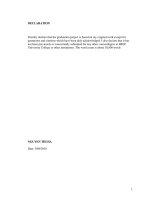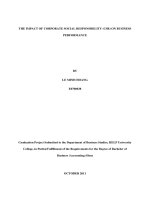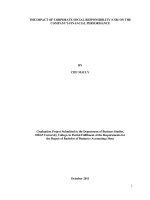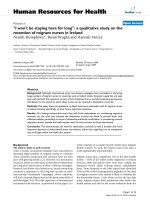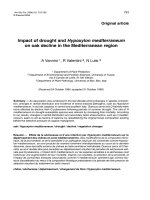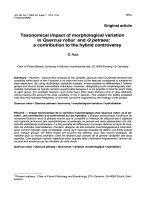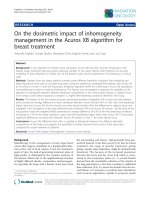The impact of the recession in ireland on training
Bạn đang xem bản rút gọn của tài liệu. Xem và tải ngay bản đầy đủ của tài liệu tại đây (1.03 MB, 131 trang )
THE IMPACT OF THE RECESSION IN IRELAND ON
TRAINING AND DEVELOPMENT, A SENIOR
MANAGEMENT PERSPECTIVE.
THE IMPACT OF THE RECESSION IN IRELAND ON
TRAINING AND DEVELOPMENT, A SENIOR
MANAGEMENT PERSPECTIVE.
Submitted by:
Cathy Martin
Student number:
10078375
Supervisor:
Mr. Eddie McConnon
A dissertation submitted in part fulfilment of the requirements of the Masters in Business
Administration (Business Management) to Dublin Business School.
August 2014
1
Declaration
I Cathy Martin declare that this dissertation is a presentation of my own work other than as
acknowledged in the text and the references. It is being submitted in partial fulfilment of the
requirements for the degree of “Masters of Business Administration” at Dublin Business
School.
Signed
Cathy Martin
Date
21/08/2014
2
Table of Contents
DECLARATION............................................................................................................. 2
LIST OF FIGURES ........................................................................................................ 6
ACKNOWLEDGMENTS .............................................................................................. 7
ABSTRACT ..................................................................................................................... 8
1
INTRODUCTION. .................................................................................................. 9
1.1
Background to the problem.
9
1.2
The research question and objectives.
9
1.2.1
1.2.2
1.3
The approach to the dissertation.
10
1.4
The organisation of the dissertation.
11
1.5
The scope and limitations of the research.
11
1.5.1
2
Research objective ...................................................................... 9
Research Questions ................................................................... 10
Limitations to the research. ....................................................... 12
1.6
The contribution of the research and the recipients of the research.
12
1.7
Justification for the research.
13
1.8
Introduction to research
14
LITERATURE REVIEW ..................................................................................... 17
2.1
Literature Introduction
17
2.2
Training and Development
18
2.3
Economic recession
24
2.4
Effective training and development
29
2.5
Reward and employee engagement
32
2.6
Literature Conclusion
34
2.6.1
2.6.2
2.6.3
Research Gap ............................................................................ 35
Research objective .................................................................... 35
Research Questions ................................................................... 35
3
3
RESEARCH METHODS AND METHODOLOGY .......................................... 36
3.1
Introduction
36
3.2
Research Design
36
3.3
Research Philosophy
37
3.4
Research Approach
39
3.4.1
3.5
Research Strategy
41
3.6
Time Horizons
42
3.6.1
3.7
5
6
7
Time Horizon: Cross-Sectional ................................................. 42
Data Collection and Data Analysis
3.7.1
3.7.2
3.7.3
3.7.4
4
Research choice ......................................................................... 40
42
Secondary research.................................................................... 42
Primary research........................................................................ 42
Selecting Respondents .............................................................. 44
Data Analysis Procedures ......................................................... 45
3.8
Validity and reliability
46
3.9
Research Ethics
47
3.10
Limitations of Methodology
48
DATA ANALYSIS AND FINDINGS .................................................................. 50
4.1
Introduction
50
4.2
Analysis of Qualitative research
51
4.3
Findings
63
DISCUSSION ......................................................................................................... 66
5.1
Research Question
66
5.2
Sub questions
71
CONCLUSIONS AND RECOMMENDATIONS. ............................................. 76
6.1
Introduction
76
6.2
Conclusions
76
6.3
Recommendations
79
BIBLIOGRAPHY .................................................................................................. 80
4
APPENDIX 1: RESEARCH QUESTION PROCESS. .............................................. 94
APPENDIX 2: VRIN MODEL .................................................................................... 95
APPENDIX 3: RESEARCH ONION .......................................................................... 96
APPENDIX 4: SECURITY CLEARANCE................................................................ 97
APPENDIX 5: INTERVIEW QUESTIONS .............................................................. 98
APPENDIX 6: INTERVIEW TRANSCRIPT 1 ......................................................... 99
APPENDIX 7: INTERVIEW TRANSCRIPT 2 ....................................................... 107
APPENDIX 8: INTERVIEW TRANSCRIPT 3 ....................................................... 111
APPENDIX 9: INTERVIEW TRANSCRIPT 4 ....................................................... 117
APPENDIX 10: INTERVIEW TRANSCRIPT 5 ..................................................... 122
APPENDIX 11: SELF REFLECTION ..................................................................... 127
Introduction
127
Evaluation of learning and development
127
Conclusion
130
5
List of Figures
Figure 1 Researcher’s Own Research Chain......................................................................................... 37
Figure 2 Data Analysis................................................................................................................ 45
6
Acknowledgments
The completion of this dissertation and the MBA programme would not have been possible
without the support and understanding of many people.
First of all I would like to thank my husband Barry for his unwavering support and belief in
my abilities, also for the countless cups of tea and words of encouragement.
I want to thank my father for his support and courage in the face of illness. He is an
inspiration and the true embodiment of never giving up.
I would like to thank my dissertation supervisor Mr. Eddie McConnon for his calm, logical
approach to supervision, constructive feedback and encouragement for this I am very
grateful.
7
Abstract
The recent recession in Ireland has had dramatic effects across the business world.
Organisations have witnessed many changes and have had to adapt to a new environment.
The area of training and development is a critical component for many organisations in their
overall performance. However in light of economic upheaval the training and development
functions within many organisations have suffered.
The aim of this research is to discover how senior managers view the impacts of the recession
on training and development in Ireland and to identify problems they have had to face and
how they have managed through the recession and beyond.
The research has found that training is regarded as hugely important despite of or in fact of
the recession and managers are willing to do what they can to ensure they can keep this
function operating. This has led to some innovative and extremely effective training methods.
The research has highlighted the importance of aligning training efforts with organisational
strategic objectives. A trend towards an increased use of internal training has emerged. The
research also presents a management view of training as a reward during tough financial
times and issues of retention and succession are also significant.
8
1
1.1
Introduction.
Background to the problem.
The global recession has forced organisations to analyse and evaluate their cost structures,
and as a result, spending is often cut in areas which directly affect employees such as training
and development. Many organisations do not readdress this area until the financial position of
the organisation becomes clearer. This is often a necessary step for the survival of the
organisation and managers are faced with many challenges as a result of reduced resources.
Cutting training and development budgets may be viewed as a less impactful way to save
money than other cost saving measures. The justification for spending on training and
development can be difficult to argue in times of economic uncertainty. The restructuring of
organisations due to lay off, redundancies and other measures can see employees take on
more and more responsibility in their day to day job roles and training and in particular
development may not be seen as the most effective use of their time. However it can be
argued that this is the time when training is needed to ensure the smooth transition of
restructuring.
There is a need to appreciate the perspective of managers in Ireland specifically in relation to
training and development and how they have dealt with the consequences of the recession.
1.2
The research question and objectives.
1.2.1 Research objective
The main objective of the research is to carry out an investigation into how senior managers
have viewed the impact of the recession in relation to training and development.
The research will look at the challenges facing managers in Ireland in this regard. This
research will aim to discover the ways in which managers in Irish business are managing the
9
training and development function within their organisations while under the pressures of an
uncertain economic climate.
The research will provide insights into the training and development function and how it has
changed. The perspective of senior managers is considered and presented in the primary
research findings.
1.2.2 Research Questions
To achieve the research objective the research question was developed using an inverted
triangle (Appendix.1) to bring the topic from the broad field of study (Training and
development) to a more specific situation (the impact of recession) to the specific angle (how
do managers view these impacts and manage the effects of recession on training and
development).
The researcher has to answer the following research question;
How has the recession in Ireland impacted on how senior managers view training and
development?
Sub questions:
1.3
Do managers cease, reduce or increase training as a result of the recession?
Is there now more focus on using training to fulfill short-term goals?
To what extent has the focus on personal and professional development diminished?
To what extent has the recession generated more creative ways of meeting training
and development needs?
The approach to the dissertation.
The researcher intends to achieve the research objectives by using both primary and
secondary research. The secondary research consists of a critical literature review based on
academic journals, texts and business research and aims to provide the reader with an
understanding of themes and issues pertinent to the area of training and development with
particular relation to the recession.
10
The primary research involves individual in depth interviews with five senior managers in
Ireland. The aim of the interviews is to present an understanding of how training and
development is being managed during the recession from the perspective of senior
management in Ireland. The perspectives and opinions of these managers will provide
valuable information for the researcher to answer the research questions and meet the
research objectives. The data collected form these interviews is analysed, discussed and
conclusions and recommendations are presented.
1.4
The organisation of the dissertation.
The dissertation consists of six chapters. The first chapter is an introduction and it covers the
main aspects of the research project including; the background to the problem, research
question and objectives, the approach to the dissertation and the justification for the research.
The aim of this chapter is to introduce the reader to the topic and to present the objectives of
the research.
The second chapter is the literature review. This chapter presents a critical review of relevant
themes within the research topic.
The third chapter is the research methodology. This chapter will discuss research methods
and the justification for the chosen methods used in the dissertation.
The fourth chapter pertains to the data analysis and findings of the primary research carried
out.
The fifth chapter presents the discussion of the research and the sixth chapter outlines the
conclusions and recommendations of the research.
1.5
The scope and limitations of the research.
This research was conducted to determine how the recession in Ireland has impacted on how
senior managers view training and development and how they have managed their training
and development functions during the recent recession.
11
The population for the research is senior managers and the location of study is Ireland. The
sample was five senior managers. The research period is the recession which began in 2008
in Ireland through to the current day.
1.5.1 Limitations to the research.
While managers interviewed represent various different industries in Ireland, there are a wide
range of training and development issues facing organisations and as such the researcher’s
conclusions cannot be generalised.
Subjectivity is a limitation encountered with qualitative research. It refers to the way in which
the research can be shaped by the particular perspectives of the researcher. Saunders and
Lewis (2012) warn of the issues of subject bias and subject error as factors which can put the
reliability of the research at risk. Ratner (2002) presents subjectivity as directing “everything
from the choice of topic that one studies, to formulating hypotheses, to selecting
methodologies, and interpreting data”.
Time constraints of the MBA programme present another limitation to the scope of the
research.
1.6
The contribution of the research and the recipients of the research.
The main recipients for this research will be the dissertation supervisor Mr Eddie McConnon
and the awarding bodies of Dublin Business School.
In addition this research will be available to the future students of Dublin Business School.
The topics researched and recommendations presented may be of benefit to future students
for further study and research.
The research will add to the existing body of knowledge in the area of training and
development in Ireland.
12
There is the possibility that research on lessons learned from the recession in Ireland could be
carried out and the researcher’s study could contribute to this research.
The primary research carried out by the researcher has considered the candid views of senior
managers this provides valuable insights that are not commonly available in published
literature.
1.7
Justification for the research.
This research aims to provide a synopsis of the current challenges faced by managers in
relation to training and development. The research findings provide a management
perspective. The researcher intends to discover the issues that affect training and
development in an Irish context as a result of the economic recession and discover how this is
managed by senior managers.
Saunders et al. (2009), state that the dissertation topic must be something the researcher is
competent in achieving and that it is of particular interest to the researcher. The researcher
believes that this study will develop and expand her knowledge of the subject matter. In
addition the researcher intends to contribute to the existing field of knowledge. It will also
improve the researcher’s research skills, develop critical thinking and analytical skills,
enhance competencies in communication and self-discipline and provide knowledge and
learning.
The researcher also believes that the study will highlight the importance of training and
developing human capital even during harsh economic times. The training and development
function of an organisation can be instrumental in implementing change management policies
which arise during times of recession in particular.
13
While organisations are forced to cut departmental budgets during a recession, the
detrimental effects of cutting training and development budgets is not always evident
straightaway however these effects when realised can take a considerable amount of time to
recover from and in some cases the ground lost is irrecoverable.
The challenges presented to managers during this time can prompt creativity and innovation.
This creativity and innovation can be targeted at the training and development function not
just at production, sales etc. There is a real opportunity to recognise more effective training
tools and practices and to be more efficient with time and resources.
The use of in-depth interviews will provide valuable insights from senior managers who are
dealing directly with the effects of the recession on their training and development functions
and will present significant insights not seen in the literature alone.
1.8
Introduction to research
This researcher aims to discover how managers in Ireland view the impact of the recession in
regards to training and development. The area of training and development is a broad one
with Swinney (2007, p.6) defining it as “the process of helping individuals develop skills and
knowledge for the purpose of improving or changing their performance”, Popescu and
Popescu (2012) see training as a short term effort with development being more concerned
with the future growth of an individual. With the support of the organisation an individual is
poised to improve performance as a result of being offered such training and development.
Resources permitting, this is the accepted view. However it is not always the case as poor
motivation and misdirection of learning needs are factors but this is not the area of concern
for the researcher.
Blanchard and Thacker (2013, p.21) point to the importance of investing in training even in
times of economic uncertainty as it contributes to improved performance of organisations but
14
they do stress that some organisations do not perceive much value from training initiatives.
This they argue can be related to the quality of the training and essentially the effectiveness
of the training. Porter (1990) also argues that there are mitigating factors to be considered in
the lack of investment in training, such as poor management, centralised decision making and
a disregard for high performers.
Another consideration is the misuse of training and development in organisations where the
culture of training was based on the need to spend the training budget because it was there,
without a training needs analysis being carried out or organisational strategic objectives being
considered.
A comprehensive literature review finds little evidence to dispute the significance of training
and development as an essential part of organisational performance. There will be
disagreement over the allocation of finance toward the training and development effort
however it is rare to find a case against the existence of it at all. Nevertheless an external
factor proved hugely influential in this arena recently. The recession has forced organisations
to cut costs to remain in business. To further define the research it is important to look at the
economic effects of the recession on training and development.
“Ireland's economic crisis is the most serious in its history, and the country's current
economic, fiscal and banking problems are among the most acute of any developed nation”.
This has been a challenging time for organisations in an environment where “between 2007
and 2009, GDP shrank by nearly 11 per cent. Unemployment rose from 4.6 per cent in 2007
to nearly 15 per cent in 2011” (Roche, 2011, p.32). It has had reverberating effects across the
business world.
Previous economic crisis see investments in human capital cut, in particular in training and
development (Sheehan, 2012) and (MacKenzie, Garavan and Carbery, 2012). “Training
programs are among the first areas to take a hit when the economy falters. Cutting training
15
willy-nilly can create more problems than it solves” (Shenge, 2014, p.53). Developing human
capital can be seen as contributing to competitive advantage, talent management and
retention of key members of staff in particular managers is vital for survival/success
(McCartney and Teague, 2001, Kennett, 2013). So it would appear that training and
development should be an essential part of the organisation’s rationale for survival however it
is often considered an unnecessary expense when times are tough.
However there is the argument that those who are spending on training and development are
being more prudent and selective thus leading to more efficiency and effectiveness of the
training and development efforts. Hence the economic challenges presented to the HR
departments of organisations have given rise the opportunity to examine and improve systems
“the economic instability of the European region has prompted many organisations to ‘batten
down the hatches’ and cut back on spend, and as a result, we are seeing a much more focused
wave of innovation in HR. . . . those who are doing it are doing it much more effectively”
(CIPD, 2013, p.5) and Paradise and Mosley (2009).
This is an area that warrants further research as it is relative to the researcher’s approach in
discovering how creative managers can be with limited resources in essence forcing them to
be more effective as outlined by Fitzgerald (2012) “Rather than doing less of the same, the
scope for doing things differently needs to be fully explored. The crisis is an opportunity to
drive that change” (P.1384).
16
2
2.1
Literature Review
Literature Introduction
It is important for this research to be framed in context with the literature in this area of
study. A comprehensive literature review is conducted to discover the relevant themes and
concepts in this field of study. It is essential to look at the concept of training and
development and the reasons for it.
Aligning training to the strategic objectives of an organisation is an area to be explored.
There is a rise in the use of strategic human resource management (SHRM) and it is viewed
as a way to focus training efforts on the strategic vision and goals of an organisation, it looks
to include the human resource department as a strategic partner of the organisation. It is vital
that employees are aware of an organisation’s strategic objectives and are informed of how
they contribute to the attainment of these objectives.
Training can be viewed as an instrument for gaining competitive advantage. It is an important
driver in maintaining an organisation’s competitiveness. Developing human capital in such a
way can also increase employee loyalty in difficult times. This effect is not limited to
employees as greater customer satisfaction can also be realised.
It is important to understand the effect of the recent recession on the area of training and
development within business. Justifying training budgets can invariably be a difficult task
particularly in recessionary times and care is needed so as to develop training systems that
offer a return on investment and have a positive impact on the organisation. There is a danger
that discretionary spending can be exploited if not monitored correctly. The incidents of this
may have been more common in boom times however the recession may have presented a
real opportunity to be selective and resourceful with training budgets.
It can be argued that training has never been more important than in times of economic
uncertainty. Consolidating skills and knowledge is a proactive step in preparation for an
17
upturn in the economy. However there is increasing pressure on managers to achieve more
results with fewer resources. Acting in a manner that can deliver effective training in a
creative way is a challenge for managers during the economic upheaval. Conversely some
organisations may indeed increase their training efforts where others have had to contract
their efforts.
Finally the concept of dealing with the effects of the economic downturn on this area is
addressed while taking the area of employee engagement and reward into account.
2.2
Training and Development
Organisations use training and development as a means to develop staff and achieve goals. It
is a benefit to both the organisation and the employee. Schüler (2000) cited in Iacob and
Andrei (2011, p.132) stated that training and staff development is essential in order to
improve business performance and achieve strategic goals. If an organisation is deficient in
this area it cannot grow and prosper. Swinney (2007, p.6) defines training as “the process of
helping individuals develop skills and knowledge for the purpose of improving or changing
their performance”. Training can also be described as a “strategic process in organisations
because of the role these activities play in developing employee skills and firm-specific
human capital” (Neirotti and Paolucci, 2013, p.93). Organisations can benefit from training
by becoming more productive, more competitive, and therefore more profitable as a result.
(Becker 1993; Blundell et al. 1999; Lynch 1992 all in Kennett, 2013, p.113).
Building organisational capabilities and capacity is supported by the training and
development function as recognised by IBEC (2013), “Training can be formal or informal,
external or internal, technical or behavioural; training objectives may be related to
productivity, innovation or regulation; training budgets may be stable, shrinking or growing”
(IBEC 2013, p.4).
18
Training and development is promoted by Garavan, Horgan and Cahir-ODonnell (2003, p.1718) as an important function in the business context as a method of adapting to changing
operational environments and as a way to remain competitive. “The impact of the recession
was identified as a strong impetus for change in both the public and private sectors”
Eurofound (2011), the use of training and development is influential in implementing change
management. However Garavan, Horgan and Cahir-ODonnell (2003) stress the importance of
effective implementation and the learning culture of an organisation as being significant in
the acceptance of training and development. Training is viewed to increase productivity
(Becker, 1975; Mincer, 1974 in Lengermann, 1996). Training can be viewed as having two
positive effects, increasing productivity “through the development and application of some
well-defined competence” and also by initiating “a ‘feel good’ effect which results in
increased worker motivation and better performance” (Felstead et al, 2010, p.1678).
Chatzimouratidis, Theotokas and Lagoudis (2012, p.662) and Tannenbaum et al (1991,
p.759) also subscribe to the idea that training and development is important for increased
motivation, employee morale and job satisfaction in turn resulting in better innovation,
increased productivity and higher quality of products and services which ultimately
contributes to financial gain for the organisation. There is however an ongoing issue of
justifying spend on training and development even pre-recession, Guthrie et al (2009),
Sawitri and Muis (2014) all purport this understanding.
Coget (2011, p.85) highlights the resource-based view that an organisation can justify
investing in training and development for this very reason. Building on Barney’s VRIN
model (1991) Coget argues that organisations have a responsibility to develop and use
valuable, rare, inimitable, and non-substitutable human resources to gain competitive
19
advantage. The VRIN model (Appendix 2) developed by Barney (1991) assesses capabilities
for their valuable, rare, inimitable, and non-substitutable properties. If these criteria are met
Barney proposes that an organisation will achieve sustainable competitive advantage but,
stating that “a competitive advantage is sustained only if it continues to exist after efforts to
duplicate that advantage have ceased” (Barney, 1991, p.102), however he warns that
possessing a sustainable competitive advantage does not guarantee it will last forever.
Resources that are valuable allow “a firm to conceive of or implement strategies that improve
its efficiency and effectiveness” (Barney, 1991, p.106). Rarity provides an advantage as
competitors take longer to react to rare capabilities, “those possessed uniquely by one
organisation or by a few others” (Johnson, Scholes and Whittington, 2011, p.90), Barney also
suggests managerial talent as a rare resource. Inimitability is where capabilities are hard to
replicate, or obtain. Johnson, Scholes and Whittington (2011) suggest competences are the
best way to be inimitable, by using processes over product, and human capital and intellectual
property. Barney has stated that contextual linking of these competences are important to
sustain inimitability as competitors may be able to imitate some resources but not have the
capacity to know how to use them effectively. Barney and Wright (1998, p.43) stated that the
careful management of resources such as human capital “are most likely to be sources of
sustained competitive advantage into the next century”, similarly this development of internal
organisational resources such as human capital is supported by Guthrie et al (2009).
However authors such as Brewster (1999) cited in Guthrie et al (2009) warn of generalising
this topic and Bryson et al (2005) cited in Guthrie et al (2009) raise questions as to
advocating this approach. The reliance on human capital as an asset to an organisation is
increasing and needs to be harnessed and managed effectively. The training and development
of such assets is a continuous and critical function.
20
Hutchinson (2013, p.39) looks at training and development as part of the overall performance
management field and relates the contemporary view that it must align with organisational
strategy and objectives to be effective in today’s business environment. This argument is
supported by Schuler (1992) who proposes linking the strategic business needs of an
organisation to the provision of human resources to meet those needs. Therefore a correlation
can be drawn between the resource of human capital and the strategic objective in turn this
should lay the foundation for training and development practices. Villachica, Stepich and Rist
(2011) warn of the dangers of implementing training without aligning it to strategic goals and
propose that it is destined to fail if not aligned correctly.
Barron (2003) agrees that training should be aligned with organisational goals in order to be
effective and in a difficult economic climate a culture should exist whereby training supports
an organisation's goals. He warns that it is not always possible to achieve this task as all “too
often, alignment remains stuck in the talk stage because the learning function isn't brought
into strategy making discussions” (Barron, 2003 cited in Green, 2004, p.99). O'Donnell and
Garavan (1997) highlight work by Tichy et al (1982) which points to three core elements
which an organisation must build on to be effective, “mission and strategy, organization
structure and human resource management” (O'Donnell and Garavan, 1997, p.301). Ramona
and Anca (2013) concur that human resource departments have an opportunity to utilise their
expertise in the formation of organisational strategy, to be involved and proactive in the
common goal for organisational success in the implementation of strategic human resource
management (SHRM).
The Chartered Institute of Personnel and Development (CIPD) define SHRM “as an approach
to the management of human resources that provides a strategic framework to support longterm business goals and outcomes” (CIPD, 2013). In essence the focus is on longer term
21
issues and needs of the business, looking forward and developing initiatives to benefit the
organisation into the future. It leaves short term goals behind and really drives the
organisation forward concentrating on key areas of culture, quality and commitment.
Most individuals feel the need to be involved in something that is greater than themselves, as
such the feeling of being part of the organisation and being of value. It is important for staff
to understand the strategic vision of the organisation and pull in the same direction thus
creating a better sense of being valued and in turn participating in a team that gets results.
However, there are difficulties in translating an organisation’s strategy in a meaningful way
to staff that includes and empowers them.
Nordhaug (2004) cited in Heraty and Collings (2006, p.166) presents the view that
organisational competitiveness is built around investment in human resources and as such is
contributing to the research into the area of human capital regarding both training and
educational factors, Mc Cartney and Teague (2001) subscribe to this concept by stressing the
importance of training in gaining competitive advantage but warn of the many organisations
who fail to train as a result of operating pressures. Such views support the significant role
played by training and development in the survival of an organisation. “Training is one of the
activities that gives organisations access to resources, including human resources, material,
money and methods, that will allow them to compete successfully in a changing environment,
and to plan and design activities to accomplish the perceived goals of the organization”
(Krishnaveni and Sripirabaa, 2008 cited in Shenge, 2014, p.50). This view is supported by
Towers Perrin (2010) where people are viewed as a source of knowledge and skills and
ultimately this can be used to and organisation’s competitive advantage.
22
How an organisation reacts to a recession is a measure of how that organisation will emerge
from an economic downturn. Panebianco (2008) points to a concentrated focus on training
during a recession as a means to giving an organisation a competitive edge. Developing
human capital and updating skills can contribute to greater employee loyalty in addition to
increased customer satisfaction and improving quality. Panebianco also advocates continuing
training during recessionary times to aid the survival of and strengthening of an organisation.
However Garavan, Horgan and Cahir-ODonnell (2003) point out that training and
development can vary greatly in an organisation and may not be ideal in all situations
depending on financial or time constraints or lack of knowledge or expertise. In worst case
scenarios it is “considered to be an isolated set of activities” (Garavan, Horgan and CahirODonnell , 2003, p.18) which has little or no clear objective, has not been aligned to strategic
objectives and has not been evaluated for its contribution to the overall performance of the
organisation. Such is the case in many organisations where training and in particular
development are seen to be inconsequential to the strategic aims of the organisation.
Swinney (2007) also debates the effectiveness of training and highlights the importance of
analysis, design and development coupled with real evaluation of training efforts and states
that if it is used for any other reason “training can often become a corporate money pit”
(Swinney, 2007, p.9). Prone (2008) also argues the point for more effective training that adds
value, “the last decade and a half has seen a growth in utterly pointless training courses and I
hope the recession will cause at least some of them to wither and die. These are the kind of
training courses which lead to no measurable improvement in performance on the job,
because they are glorified talking shops based on ‘A Model’” this is supported by the view
that the recession will lead to this type of ineffective and often expensive training being
disbanded to the benefit of both employees and organisations (Prone, 2008).
23
2.3
Economic recession
Ireland is a small trade dependant country that has suffered a historic recession, “Ireland's
economic crisis is the most serious in its history, and the country's current economic, fiscal
and banking problems are among the most acute of any developed nation” (Roche, 2011,
p.32). Since 2008 Ireland has witnessed what is believed to be the most significant economic
event since the foundation of the state. McHale, (2012) presents an overview of the Irish
economy in his study of developments over the decade 2002-2012. His insight into what he
classes a ‘bubble economy’ range from the over inflated property and construction culture to
the “faith in efficient markets and the effectiveness of risk management techniques; and the
belief in the efficacy of light-touch regulation” (McHale, 2012, p.1226) as contributors to the
overall economic crisis in what he describes as a “breakdown of both market and regulatory
discipline” (McHale, 2012, p.1234). Fitzgerald (2014) states “the economic crisis that hit
Ireland in 2008 stemmed from an uncontrolled real estate bubble” (Fitzgerald, 2014, p.8) in
support of McHale (2012).
Likewise the wave of the global economic recession coupled with catastrophic banking crisis
added to a massive property crash which “led to an unprecedented contraction in national
output and income and to a fiscal crisis, resulting in Ireland having to accept a ‘bail out’ from
the European Union (EU) and the International Monetary Fund (IMF)” (Maître, Russell and
Whelan, 2014, p.1).
Consequently the knock-on effect on the country was devastating for many with
unemployment increasing drastically, house prices tumbling, and austerity measures to adjust
to, leaving the economy fighting for survival. An over reliance on the property and
construction sectors meant that when the construction sector collapsed it had severe
consequences which saw house prices plummet, thousands of construction workers
24
